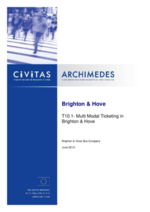Multi-modal ticketing
Thematic areas
Collective passenger transport & shared mobility
Summary
Brighton & Hove introduced a multi-modal ticketing system to enable passengers to travel seamlessly by bus, rail and other means of public transport.
Implementing sustainable mobility
This measure involved the introduction of a multi modal ticketing system – that abled passengers to travel seamlessly by bus, rail etc. with the purchase of 1 ticket to cover their entire journey irrespective of changes in transport type.
Users will ultimately be able to load a bus and a train product onto their card and be able to travel where they want, when they want on Brighton & Hove Bus and Coach Company buses and Southern Railway trains , in line with the products purchased.
Brighton & Hove Bus and Coach Company is the lead partner in this initiative; a fleet of 280 buses is operated on an intensive network which operates 24 hours a day, 7 days a week, throughout the city and to neighbouring towns in East and West Sussex.
Progress
The implementation process was severely delayed at many stages of the measure. Ticketing machines were installed on buses early in 2011, testing commencing in June 2011, with a publicity campaign following over summer 2011, and initial public trials of the system began in September 2011. The system was gradually introduced, starting with only students in September 2011, and then a full roll-out to all took place from April 2012.
Outcomes
Due to severe delays to the implementation process, evaluation did not commence until May 2012. Brighton & Hove Bus and Coach Company were responsible for monitoring and evaluating the measure, focussing primarily on social awareness and acceptance of the scheme, and an analysis of patronage data.
- Patronage of Brighton & Hove Buses has increased by over 5.5 million over the past 6 years, up to the point of implementation of this measure;
- Continued fare paying passenger growth of approx. 4.64% year on year for the 12 months ending 30 June 2012 (already superseding figures given in C2.3, which shows that the smartcard is already having a positive effect);
- Smartcard journeys by commercial passengers increased from around 800 per day in early September 2011 to approximately 35,000 journeys per day by September 2012.
A considerable amount of work was undertaken, which was more challenging than originally conceived, involving numerous external suppliers and changes in working methods across the organisation. This involved close project management at all stages of the roll-out.








